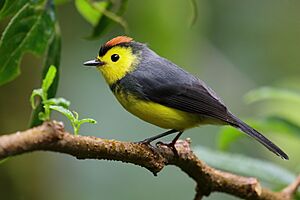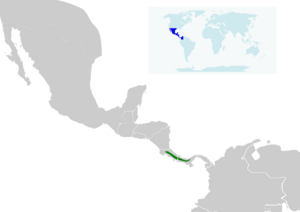Collared whitestart facts for kids
Quick facts for kids Collared whitestart |
|
|---|---|
 |
|
| In Costa Rica | |
| Conservation status | |
| Scientific classification | |
| Genus: |
Myioborus
|
| Species: |
torquatus
|
 |
|
The collared whitestart (Myioborus torquatus) is a small, colorful bird. It's also known as the collared redstart. This bird lives only in the mountains of Costa Rica and western-central Panama. It's a type of New World warbler, which are small, active birds.
Contents
Meet the Collared Whitestart
The collared whitestart is about 13 centimetres (5 in) long. That's about the length of a smartphone. It weighs around 10.5 grams (0.4 oz), which is lighter than a pencil. This bird has a bright chestnut-colored cap on its head. This cap is outlined in black. Its forehead is also black.
The upper part of its body is a dark, slaty black color. Its tail is black with white edges. This is why it's called a "whitestart." "Start" is an old English word for "tail." The bird's face and belly are a vibrant yellow. It also has a black band across its chest, like a collar.
Both male and female collared whitestarts look very similar. Young birds are a bit duller. Their backs are browner, and their bellies are only weakly yellow. Their heads are entirely slate-colored, without any yellow on the face or red on the crown.
How Collared Whitestarts Behave
Sounds and Calls
The collared whitestart makes a sharp pit sound. Its song is a mix of slurred whistles, warbles, and trills. These sounds help them communicate with other birds.
What They Eat
These birds love to eat insects. They often fan their striking tails while chasing their prey. This fanning might help to scare up insects, making them easier to catch. Collared whitestarts will also join groups of different bird species to feed together. They sometimes follow cattle or even humans to catch insects that get stirred up from the ground.
Building a Home
The collared whitestart builds a special nest. It's shaped like a dome with a round entrance on the side. They build these nests on the ground or on a steep bank. They hide their nests among rocks, clumps of grass, or under fallen logs.
The nest is made from strips of bark, plant fibers, leaves, and grass. From March to May, the female bird lays 2 or 3 eggs. The eggs are white or cream-colored with small brown spots. The mother bird sits on the eggs for about two weeks until they hatch.
Where Collared Whitestarts Live
The collared whitestart is a common bird in certain areas. It lives in mossy mountain forests. You can find them in ravines, areas where trees have grown back (called "second growth"), and nearby pastures. They usually live at heights between 1500 meters (about 4,900 feet) and the timberline. The timberline is the edge of the forest where trees stop growing due to cold or wind.


